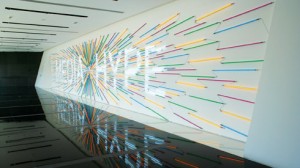Source: www.timesofmalta.com
Downtown Dubai. I love the sound of that. As much as I love the images triggered at the mere mention of this place.

Described as “the new heart of the city” and “the centre of now”, Downtown Dubai is an inspired urban concept that has come to include the world’s tallest building (Burj Khalifa), largest shopping mall (Dubai Mall) and largest fountain, in a city that has become renowned for its cutting-edge architecture and sky-scraping ambition.
Downtown Dubai, however, is far from being a “home” to random superlatives. It is an all-embracing concept that recognises the need to cater for various audiences. Thus, three weeks ago saw the inauguration of Dubai’s first dedicated non-commercial contemporary art space – The Pavilion Downtown Dubai.
Amid the towering glass and concrete jungle, The Pavilion is a quiet industrial-feeling, one-storeyed Mecca for art and artists. And simply put, it is an immaculately pristine space which exudes good taste and sleek design.
However, Dubai is hardly considered a cultural destination – precisely the reason why so much is being done (and invested) in order to alter that perception. Both private and public bodies have come to recognise and acknowledge the importance of the city’s human resources and creative economy as a whole and seem intent on propelling it forward.
Currently in Dubai, a great many events – collectively dubbed as art week – are steadily underway until Sunday. The Art Dubai fair, for example, just opened to the public yesterday while The Emirates Airline Literature Festival, has just come to a close, while concerts and miscellaneous other events have all been concentrated around mid-March, making Dubai quite a potential cultural hotspot. Thus, the launch of The Pavilion couldn’t have come at a timelier hour.
With few national museums and no museum of modern or contemporary art, Dubai has had to rely on the smaller galleries and art spaces to act as launching pads and showcases for artists. Thus, the opening of The Pavilion gains further significance in this respect; so much so that it is being lauded by the Dubai Culture Authority as well as by Art Dubai fair director Antonia Carver.
Originally the sales office of Emaar Properties, The Pavilion was designed by Studio M’s Canadian interior architect Abboud Malak who was also the lead interior designer for the Dubai International Financial Centre (DIFC) at the Gate building, where several prestigious galleries as well as the headquarters of the Art Dubai team are located.
The Pavilion has two exhibition spaces, dubbed Gallery One and Gallery Two, a rather spacious cinema, a library, restaurant, espresso bar, shisha café and lounge areas both on the exterior and interior of the space. There are also bike rental options, for those keen on cycling around the Downtown area. In all, The Pavilion comprises a space of some 1,400 square metres.
One of the dominant and more playful features of The Pavilion is an interior shed behind which a vertical garden is found – an element which adds considerably to the interesting combination of textures at play. What’s even more discerning of this outdoors/ indoors notion is the essentially glass façade which makes it possible for visitors to view the 200-plus-storey Burj Khalifa from within the space.
Amazingly, yet apparently typical for this city, The Pavilion was realised in a matter of a few months, even though the space had been lying empty for a few years. Emaar, together with the multidivisional group Cultural Engineering, joined forces to renovate this building, which has now become a haven in which one can simply indulge and savour the atmosphere, the art and even the sumptuous cuisine.
Aside from the stunning design, The Pavilion offers all an artist could wish for: plenty of natural light, neutral surfaces/backgrounds for exhibits, state-of-the-art facilities and plenty of room where ideas can converge.
The Pavilion’s cultural programme is currently presenting site-specific light installations by James Clar in collaboration with Traffic Gallery; a short film by Laleh Khorramian titled Water Panics in the Sea in collaboration with The Third Line and screenings in the cinema portraying a collaborative project by Hypebeast.com and Brownbook magazine.
On The Pavilion’s exterior however, one can also admire the gorgoeus architectural installation by Lebanese interior designer Pierre Abboud. Titled The Falcon’s Nest, the work stands at an impressive seven metres in height and 16 metres in width. Made out of thousands of pieces of wood, the installation stands in stark contrast to the highly polished glistening façades of the surrounding complexes.
It is oh so easy to be become enchanted by this city. Perhaps it’s because Malta is so disproportionate in comparison to Dubai that I couldn’t help feeling at least slightly smitten with this desert-cum-über-cosmopolitan city. Funnily enough, I found Dubai to have more aspects in common with Malta than immediately meet the eye. Dubai’s cultural fabric struck home, simply because of the yearning to bring about change. Their salient difference is that both the private and public sector is willing to invest in contemporary culture whereas Malta is still struggling to understand, preserve and promote its heritage let alone its contemporary culture.
Yet, there is much which can be learnt from a city that flourished from the sands and soared to the skies in a matter of a decade or so.
The Middle East is bursting at the seams with talent which seeks representation, recognition and promotion which they are steadily achieving through perseverance, will and belief in the county’s product. Shouldn’t we be following suit?
Ms Baldacchino travelled to Dubai courtesy of Emirates.












